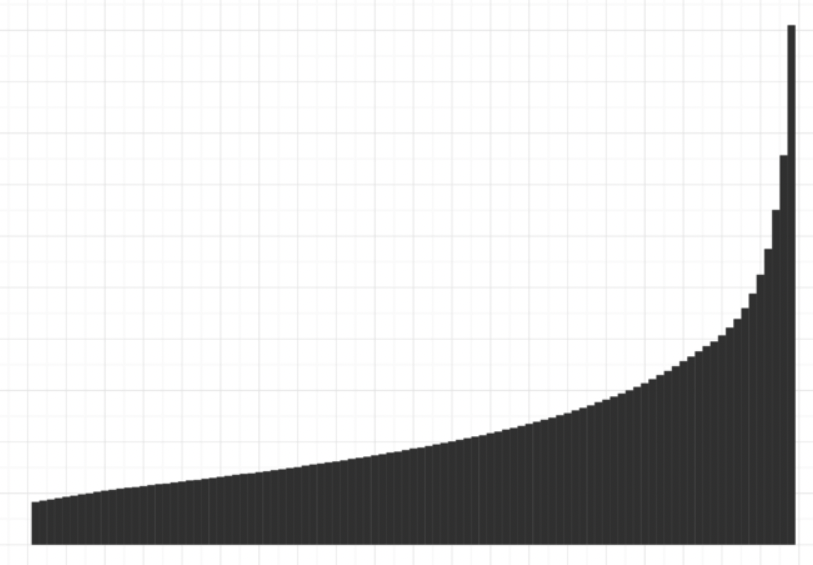
In this article, we going to cover the 5 steps where you can go from making $0 to $10,000 per month to $25,000 per month to $100,000 per month to $1,000,000 per month or more.
We’ll list out all the steps and all the features and approximate income levels associated with each.
Table of Contents
#1 Job ($0 to $10,000+ per month)
When we first start working, we have our skills and those are applied to a job, which typically has a fixed salary.
You trade your time for money, so you’re inherently limited in how much you can scale your income.
You can learn more skills and have some level of leverage in how you do your job, such as using technology and assistants to help you get more out of each hour.
But when using your time, you’re going to be tapped out at some point. You have low leverage and limited time freedom.
You might be anywhere from a minimum wage employee all the way up to a skilled white-collar professional making many hundreds of thousands per year.
But at some point, your income is going to be limited by your time.
From here you’re going to need to identify opportunities for growth in order to climb to the next rung on the ladder, which brings us to rung #2.
Your skills and your audience are your income.
Skills + Audience = Income
In this stage, you’re focused on writing, marketing, video, SEO, and so on.
Your goal in Stage 1
The goal in this stage is to develop skills.
The risk in this stage is that you become comfortable and it’s like golden handcuffs where it’s hard to break out of.
This is often true with professionals like lawyers, engineers, or doctors where their leverage is limited by their salary and benefits are enough to make them just comfortable enough.
And often they can’t leave because they’re locked in with their lifestyle. They might have a house, cars, kids, and other luxuries that consume a lot of money each month.
So it’s too risky to become an entrepreneur or they might not have the confidence to become one or know where to start.
#2 Freelancing ($10,000 to $25,000 per month)
The first step to scaling your income is to determine how much you’re worth. This means calculating how much revenue you bring in per month, and how much profit you make after expenses. Once you know your monthly revenue and profit numbers, you can start thinking about how to increase them.
The second step is to identify opportunities for growth.
This could mean expanding your business into new markets, or increasing your prices to generate more revenue. Whatever the case may be, it’s important to have a plan for how you’ll grow your business before you start trying to scale it.
Freelancing lets you pick and choose which clients you’d like.
You can also use digital assets, such as a personal website, YouTube channel, listing your services on Fiverr or Upwork or wherever relevant platform to help promote yourself.
Once you’re at a certain level of busy, you can increase prices. You’ll also have more cash flow to help invest into other employees to help you with admin and other tasks.
But freelancing also carries its own limitations because you are still restrained by the time element of selling your own services.
But by this point you should have fans and some level of popularity and influence, which can give you another lever to scale.
Your goal in Stage 2
Your goal in this stage is to develop an audience.
You might want to develop your own platform in this stage (like a blog) to work on the side.
It’s to start taking action and learning, so you can prepare for getting to a stage of how to leverage an audience.
Also: 61+ BEST Small Business Ideas for 2024

#3 Affiliate ($25,000 to $100,000 per month)
Affiliate marketing is when you sell others people’s products instead of your own.
This has the capacity to create much more leverage because it’s not your product, you don’t have to do customer support, and don’t have to deal with returns.
Instead, you use your traffic and audience to sell products (through your blog, YouTube channel, email list, social media presence) in exchange for a commission.
The benefit of this is that your income is no longer so dependent on your time and the amount of effort you put in.
You have to build content, an audience, and systems, so it is a lot of work, but it’s something that can shoot your income up to a level that wouldn’t be possible just using your time.
It’s also important to choose products that you believe in and that are a good fit for your audience.
You don’t want to be selling something just for the sake of making money because it will show, and people will catch on and you will lose credibility with your audience if you’re just trying to sell things.
Good affiliate marketers can amass $25,000 to $100,000 per month, or more. It really depends on how much traffic you can generate, and how high converting the products you’re promoting are.
But once you have things set up, it can be a very passive form of income because you’re not trading your time for money.
Your goal in Stage 3
Your goal in this stage is to build leverage, and increase your content and sales funnel so you can build more leverage, which will come in handy in Stage 4.
Here you’ll typically start outsourcing tasks and perhaps even some of your content creation.
Here you’re getting to a point of passive income so you can replace your salary.
Usually in this stage you’re not ready to sell your own product. You don’t have the infrastructure, the copy, the sales funnel, and everything else that goes into selling your own product.
Also: 107+ BEST High-Paying Affiliate Programs for 2024
#4 Selling your own products ($100,000 to $250,000 per month)
This is where you start scaling by creating your own products.
Affiliate may have given you a really strong base off which to work, which gives you the skills to uplevel into selling products, which may be informational or something else.
You’re now at a state where you’re creating your own sales and funnels. Email is another lever. YouTube is often another that can be very helpful outside a blog and other social media.
This is also the point where you may also have to start hiring or it may be very helpful to have outside help.
The business becomes a bit more complex at this point and you might also not master all the skills (though you may).
Your goal in Stage 4
Your goal in this stage is to build your market value and start growing your revenue to a point where you can start having more flexibility to hire, invest in paid ads, and other things involved in a business.
#5 Media ($250,000 to $1 million+ per month)
When you’ve grown your blog, YouTube channel, and other platforms to this stage you are at the ultimate point of leverage.
In this stage you’ll have systems for both the sales side and the content side.
Hiring will pick up a lot here. In the beginning, it was just you doing all the content creation.
Here you’re making enough to hire several employees and start scaling everything about your business.
Before, you might’ve been able to only manage a few articles a week.
A big media site, however, can often publish dozens of articles per day and produce videos, which is how they capture so much attention, traffic, and namebrand recognition.
Lots of leverage points will pop up at this point.
Celebrities at this level like Tony Robbins can demand tens of thousands (if not more) just for a speaking engagement. Sponsorship deals can command lots of money.
Mass scaling is possible at this point. And you will build the power to hire those who are good at certain things that might be missing from your marketing strategy.
This might mean taking advantage of a certain social media platform you’re not currently on, hiring a video editor, and so on.
Your goal in Stage 5
Your goal is to scale your sales and content business in ways that they can be scaled business of the revenue you’re taking in.
Ultimately, you’re trying to build as many leverage points as possible through the new content you’re producing and doing things at a level of speed and quality that are not possible without a larger budget.
You are also a true business owner at this point. You are overseeing the entire process and designing the machine and stepping back from certain things. For example, you may no longer write all the content anymore.

Conclusion – How to Scale Your Income
These are the five stages of how to scale your income.
First, you start with your job and build your skills in that capacity.
When you have skills and leverage you can begin freelancing to better dictate where your time is going. If you’re at a certain level of business, you can raise your rates.
After that, once you start building an audience and some amount of leverage, you can start leveraging affiliate marketing where you can make a commission whenever you make a sale.
Once you become good at affiliate marketing and it’s relatively passive, you can start thinking about how to provide value to your marketplace through your own product. This takes copywriting and sales skills.
Once you’ve conquered this step, you’re in the stage where you can become a larger media conglomerate and really be at a stage where your revenue can help scale everything.
You’re also at the point where you can start hiring and have a real business.
At each stage, your goal is to scale until you reach the next level, almost like a ladder.
It’s a process that takes time, but if you follow these steps you’ll be well on your way to scaling your income to new heights.


![Backwards 3: How to Type "Ɛ" [EASY]](https://softwareblade.com/wp-content/uploads/2022/02/Screen-Shot-2022-02-19-at-9.03.25-PM-150x150.png)